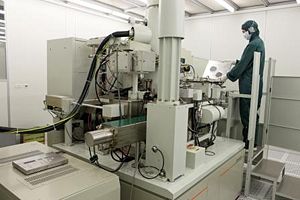Specific Process Knowledge/Lithography/EBeamLithography: Difference between revisions
| Line 23: | Line 23: | ||
|- | |- | ||
|style="background:LightGrey; color:black"|Max. e-beamed area | |style="background:LightGrey; color:black"|Max. e-beamed area without stitching | ||
|style="background:WhiteSmoke; color:black"| | |style="background:WhiteSmoke; color:black"| | ||
*1mm x 1mm | *1mm x 1mm | ||
Revision as of 13:13, 13 June 2013
The JEOL JBX-9500 electron beam lithography system is a spot electron beam type lithography system designed for writing patterns with dimensions from nanometers to sub-micrometers. The maximum field-size without stitching is 1 mm x 1 mm. The machine is located in a class 10 cleanroom with tight temperature and moisture control. The room must only be entered when the machines or equipment inside the room is intended to be used.
The computer controlling the e-beam is located in the controller room which is a class 100 cleanroom area. The computers supporting the conversion of the e-beam files (DCH1350 or DCH1352) are also located in the controller room.
Overview of the performance of the e-beam writer
| Purpose | pattern an electron sensitive resist | Mainly for pattering structures with minimum feature size between 1 µm to 20nm |
|---|---|---|
| Performance | Resolution |
|
| Max. e-beamed area without stitching |
| |
| Process parameter range | E-beam voltage |
|
| Scanning speed |
| |
| Min. electron beam size |
| |
| Min. step size |
| |
| Beam current range |
| |
| Dose range |
| |
| Samples | Batch size |
Wafer cassettes:
|
| Substrate material allowed |
|
Getting started
To request a training session or a time-slot for the e-beam, contact the e-beam team via this link: e-beam@danchip.dtu.dk'
You need 3-4 training sessions before being allowed to use the e-beam writer. You can get training in loading and unloading samples into a cassette, to optically pre-align the samples, to calibrate the writer, to perform 2nd alignment and start exposure. For safety reasons, the costumer is however not allowed to load or unload cassettes to or from the e-beam writer.
Before you request for a training, it is recommended to have as much of your pattern ready in either tdb-format or GDSII format. In order to reach the files from the computers inside the cleanroom, it is recommended to either dropbox them or send them per email to yourself. The original JEOL JBX9500 manual (1500 pages) is located on the N-drive (under _Equipment/E-beam).
It is also recommended to gather as much knowledge about your e-beam run from your colleagues, i.e. which e-beam current, aperture and dose to use, which shot pitch (e.g. SHOT A,10). In order to get an overview of what an e-beam process requires, it is recommended to a assist a fully trained colleague of yours when she or he e-beam writes. Furthermore, please read the e-beam manual for more information on which parameters to use.
On the L-drive, a logbook for the e-beam writer can be found. Sheet 1 gives you an overview of which condition files (currents and apertures) have been in use recently by which user on which type of resist. On sheet 2 in this logbook you can find a writing time estimation program; please use this prior to requesting e-beam sessions. If in doubt how to use it, contact the e-beam team.

